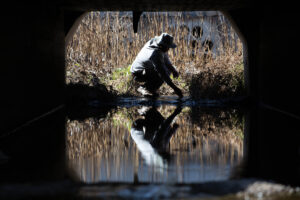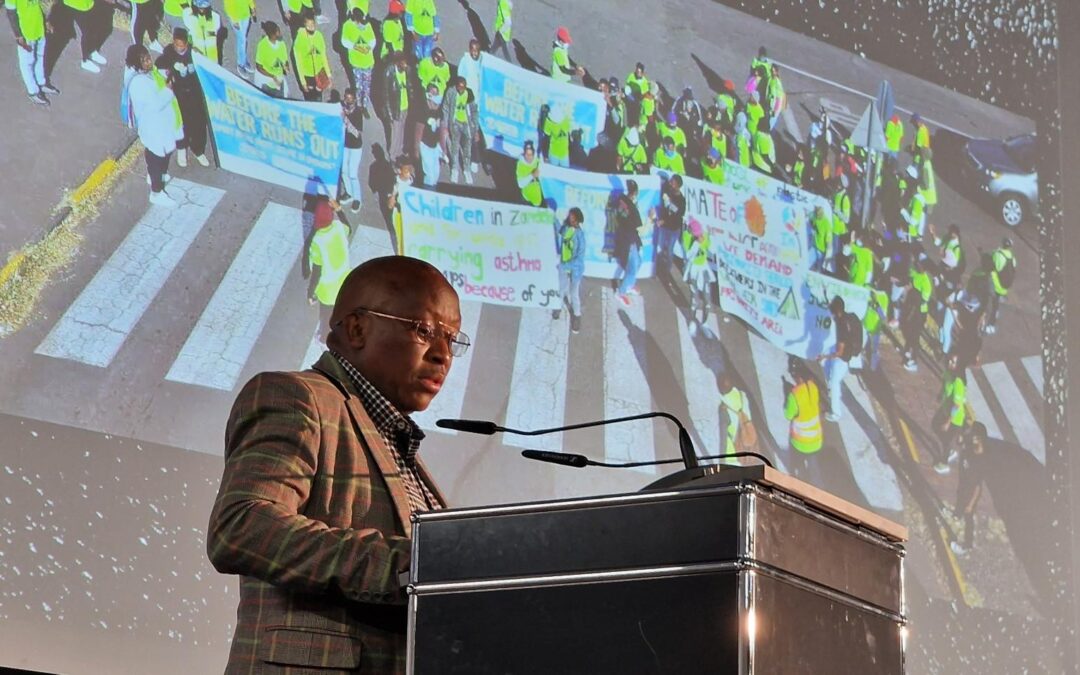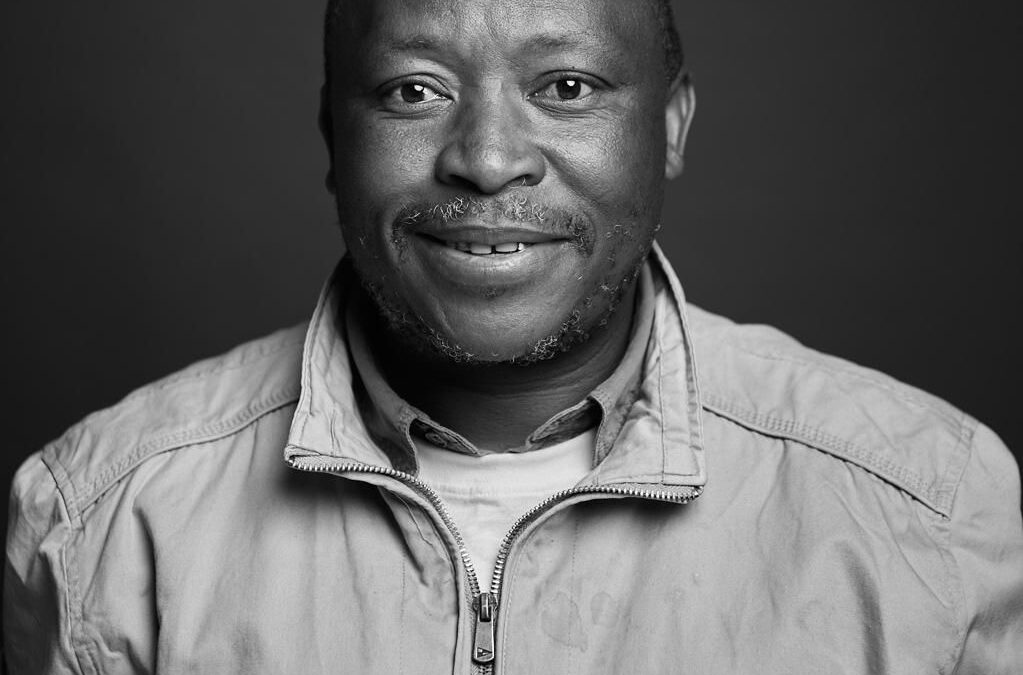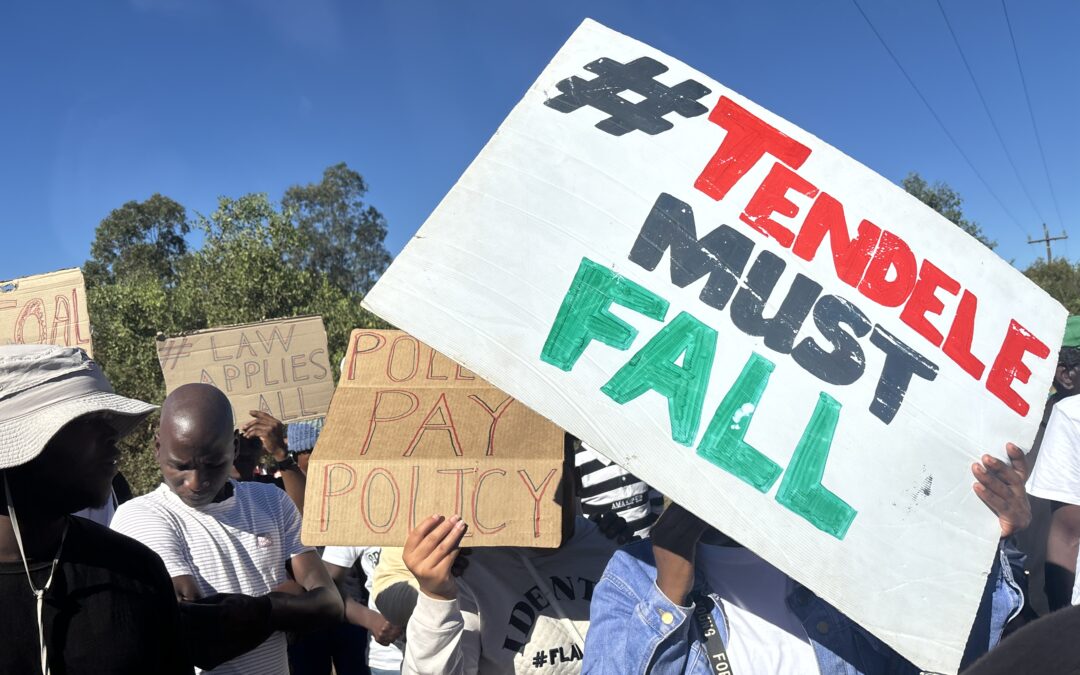
Samson Mokoena showing tar emerging from sampling boreholes on his hands after a VEJA monitoring exercise. Photo by James Oatway supplied by Centre for Environmental Rights.
Samson Mokoena and the struggle for a clean environment in the Vaal
By Victor Munnik

Samson Mokoena taking a water sample in Steel Valley. Photo by James Oatway supplied by Centre for Environmental Rights.
I still can’t believe that Samson is gone. That I will never again – except in photos and films – see his face, at once intense and friendly, hear his strong voice and feel his warm, comradely hug. We have been comrades in the struggle for environmental justice – particularly around water and air pollution for 23 years now. He was not only a friend, but an important leader in the struggle for environmental justice in South Africa, Africa and the world.
Samson was a person for whom the description “the struggle is my life” was made. He was still a youth, and a member of the ANC Youth League when his father invested his life savings (his pension) in a smallholding in Steel Valley. There were rumours at the time, Samson told me later, that the area had been polluted by the giant steel mill – then Iscor – and that no-one should buy there. But it was the early 1990s and legislation stopping Black people from owning land in “white” South Africa had just been repealed. Samson’s father, and other prospective Black landowners, like Strike Matsepe, dismissed the rumours as racist attempts to prevent Black people from buying land there.
They were sadly mistaken. The South African apartheid parastatal Iscor had been polluting the area since they started operations in 1961. When the new South African water law in 1965 obliged them to regulate their water quality, they did tests. Documents show that from then on, they knew that dirty water leaving their factory was polluting the smallholdings to the west of them. It was flowing down a canal to smallholdings that – according to the title deeds of these properties – could be used for irrigation of crops. There were no warning signs, so children swam in the polluted water without a care. The huge Iscor uncapped slagheap across the road from these smallholdings covered them in fine, toxic dust when the wind blew. And the tar filled water from the coke ovens seeped into the fractured rocks and aquifers of Steel Valley, through a holding dam that had no protective lining. This pollution also seeped into people’s bodies.
As the old and new residents of Steel Valley discovered the pollution. They also discovered that a number of farmers had already signed agreements for compensation based on non-disclosure with Iscor as a result of the pollution. But people hoped for something better. It was the new South Africa. The new local government supported these farmers with water quality tests. They even worked on competing relocation plans, but these would be only for some selected owners, and for others, like ANC local government official Neville Felix, it would be a relocation plan to move the whole community including labour tenants and farm workers.
A forum initiated by the Department of Water Affairs in 1996 put a heap of pollution evidence on the table. Justice would be done. But in 2000 the department and Iscor backed out and collapsed the forum after a group of white smallholders (maplotters as Iscor management derisively referred to them), the Johnny Horne group, had taken Iscor to court in 1998. They won a settlement, Iscor bought out their farms and they left. Another mixed group of 16 applicants from across racial divisions decided to repeat this in 2001. Samson’s father was amongst them, and so Samson got involved in a struggle for environmental justice that would last for the rest of his life. This second attempt failed and Iscor a single buyer in a devastated Steel Valley, got to buy out the remaining smallholdings on the cheap. The big polluter had won the second round, but the people of Steel Valley were not ready to give up.
During the court case, Iscor obtained a gagging order against the 16 applicants. In response, the children of the 16 applicants formed the Steel Valley Crisis Committee around which the Vaal Environmental Justice Alliance (VEJA) grew.
I first met at Samson Mokoena around 2001, when we were preparing for the World Summit on Sustainable Development (WSSD), a 10 year repeat of the famous Earth Summit in Rio de Janeiro in 1992, that produced the equally famous Agenda for the twenty first century, Agenda 21, with its forty chapters outlining the responsibilities of various groups for a sustainable planet, and what should happen in terms of water quality, oceans, climate change and other burning environmental questions. During the WSSD the Steel Valley struggle became the object of worldwide attention as environmentalists who had flocked to the summit in Johannesburg, drove the 70 km from Johannesburg to Vanderbijlpark, to talk to people, witness protest marches and see the pollution for themselves.
In 2004, the Iscor steel mill was sold to Lakshmi Mittal, a global steel magnate who later also bought the Luxembourgian Arcelor steel company to create AMSA. It was reported that he had built his family a jewel encrusted pool.
In the same year, Steel Valley residents now united with other communities fighting pollution in the Vaal Triangle, founded VEJA. Affiliates included the Samancor manganese workers suffering from manganese poisoning, affiliates who were working to beautify the place, create food gardens and grow indigenous medicinal plants, NUMSA ex-workers, the then powerful Anti-Privatisation Forum and Working Class Crisis Committee. I started research for my PhD[1] in environmental studies on the tactics and strategies Samson’s family and the Steel Valley residents used in their struggle to end pollution and find justice for the residents, and the politics of knowledge that protected the managers from taking responsibility for their impacts on people and their environments. VEJA invited me onto their steering committee, on which I served for the first four years.
I particularly recall a “Day of Remembrance” in 2007, in what remained of Steel Valley after Iscor/AMSA had bought out the vast majority of farms and bulldozed them into nothing. We were standing in the Highveld cold on Strike Matsepe’s smallholding, one of the few houses that still defiantly clung to the landscape. We planted crosses in the polluted earth in remembrance of those who had not only lost their livelihoods and health, but also their lives.
In 2014 VEJA won a major legal victory in the supreme court. AMSA was forced to release its master plan after more than 10 years of refusal and struggle. In the plan, AMSA detailed information describing the pollution it had all along claimed did not exist, and revealed plans for cleaning up the some of the pollution, as well as plans to live with pollution that was too difficult or expensive to deal with, for example the tar from the coke ovens in the groundwater beneath what used to be Steel Valley.
Samson was a true leader and activist. He was never short of energy to connect and learn, to debate and advocate, to organise, to protest and to struggle. His political positions were clear and engaged, and he could navigate the tricky terrain of politics in the Vaal. He played a leading role in VEJA activities as VEJA engaged on the streets, in boardrooms and corporate annual general meetings, in the broader EJ and social justice movements, in the media and policy forums. The list of activities and struggles VEJA embarked on is long. It is evidence of their broad and spirited engagement, for many on a volunteer basis. VEJA got involved in, amongst others:
- The Rietspruit catchment management forum, where water pollution from the steel factory, gold mines and as part of South Africa’s slowly developing catchment management system was discussed. Samson briefly chaired this forum until he decided that he would have more freedom to speak as an ordinary member.
- Research for the Water Research Commission into citizens science for water quality. In this project, VEJA engaged with traditional healers to claim their space as water users whose needs were not being met or even recognised in legislation.
- Samson played a long-standing role in the SA Water Caucus (founded in 2001), bringing water activists together nationwide, and built up the Free State Water Caucus (like the Vaal Triangle, VEJA extended into the Free State starting with Sasolburg).
- The Highveld Air Quality Priority area, an attempt to work with officials to monitor air quality and discipline dirty industry in the area, to improve air quality in the Vaal.
VEJA worked closely with other parts of the EJ movement, including groundWork, Earthlife, the Centre for Environmental Rights, the Benchmarks Foundation and the Environmental Justice Fund. VEJA, under Samson’s guidance, also engaged middle class activists in Save the Vaal Environment and the local campus of the North West University. VEJA involved the Human Rights Commission in a hearing on the water pollution in the important Vaal River, and many more, too many to mention. The struggle, against pollution, for better regulation by the state, for people’s health and wellbeing and building a strong EJ movement, is a long and difficult one.
The last time I worked with Samson was in a research project this year, in support of a global green steel movement which was pressuring Arcelor Mittal to make the same investments in their South African and other global South countries steel mills, as they were making in their “First World” European operations. It was part of a decarbonisation push. The research revisited 20 years of VEJA’s existence and work. Samson was in the room with us, but he was often interrupted, having to visit the doctor or go to the hospital. The years of pollution, struggle and stress were beginning to take their toll on him. On Friday 28 June 2024 he left us for good.
Victor Munnik is a groundWork researcher and research associate at the Society, Work and Politics (SWOP) Institute at Wits University.
For information please contact:
Dorothy Brislin, Senior Communications Campaigner at groundWork 082 319 3741 , cc
Images of Samson Mokoena (please note photographer James Oatway as credit for images in this folder): Folder includes image of tar on Samson’s hands referred to in the article.
https://drive.google.com/drive/folders/1kWSUFE
August 24, 2016. Effects of pollution from Arcelor Mittal South Africa on the surrounding area. Vanderbijlpark, South Africa. Centre for Environmental Rights (CER). Picture: JAMES OATWAY for CERektEVudUTBXAYNGMaTEIzWhroG?usp=drive_link
Kindly publish the following announcements with this article:
- Partners in the #LifeAfterCoal campaign, groundWork, friends of the Earth South Africa, Centre for Environmental Rights and EarthLife Africa, VEJA and other organisations in the environmental justice movement will arrange a hybrid memorial service later in July to be announced.
- The Environmental Justice Fund has set up a BackaBuddycampaign to raise and process funds for immediate support to Samson’s family for funeral costs, and thereafter to set up an educational trust for his children.
https://www.backabuddy.co.za/campaign/in-memory-of-comrade-samson-mokoena
[1] https://wiredspace.wits.ac.za/items/133c60c8-df61-4fba-9c43-0f396682af58/full for the thesis. See also the groundWork Report 2006, Poisoned Spaces: Manufacturing wealth, producing poverty, at https://groundwork.org.za/category/reports/ and Throwing Stones at a Giant: an account of the Steel Valley struggle against pollution from the Vanderbijlpark Steel Works at https://ccs.ukzn.ac.za/default.asp?3,28,10,2449



